del UCLA Chicano Studies Research Center,
el Arhoolie Foundation,
y del UCLA Digital Library
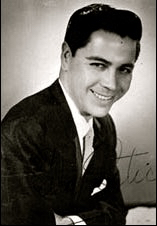 During most of the 20th century, the world of Latin pop music was dominated by a handful of countries – Mexico, Cuba, Argentina, and of course, Spain. But in the 1950s, an exception to that rule became a sensation. His name was Lucho Gatica, and he came from Chile.
During most of the 20th century, the world of Latin pop music was dominated by a handful of countries – Mexico, Cuba, Argentina, and of course, Spain. But in the 1950s, an exception to that rule became a sensation. His name was Lucho Gatica, and he came from Chile.
Gatica emerged from a small town in central Chile to become one of the most popular Latin American vocalists of all time. In a career that spanned 70 years, he sold millions of records around the world, packed theaters and stadiums from Madrid to Manila, starred in movies, and became a celebrity in Hollywood where his friends included Frank Sinatra and Ava Gardner.
The singer’s success was built on his unique ability to convey the romantic, lyrical, and passionate essence of the song style known as the bolero. His repertoire includes many distinctive interpretations of compositions still considered classics of the genre. Add to that his matinee-idol good looks and his on-stage charisma, and Gatica was destined for superstar status.
Last month, the voice of the artist known as El Rey del Bolero was silenced forever. Gatica passed away at his home in Mexico City. He was 90.
“Lucho Gatica has his name inscribed on the hearts, not only of Chileans of all ages, but also of romantics everywhere,” said Education Minister Mariana Aylwin in 2002 on the artist’s 50th anniversary when he was given his nation’s top award in the arts. “For entire generations, his name has been almost synonymous with love. He is a man who has turned many strangers into lovers.” 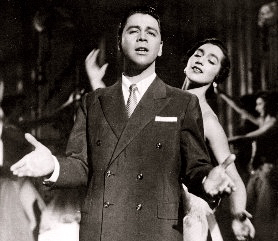
Gatica was one of the few pop artists who managed to survive the ups and downs of the fickle music market. As the years went by, he was often asked for his thoughts about the latest trends.
"There is certainly less romanticism nowadays,” he once said. “But we must accept that young people have their own rhythms, their own style of singing. I respect that because I believe every artist has their own time. And mine was wonderful.”
A Native Son of Rancagua
Luis Enrique Gatica Silva was born on August 11, 1928, in Rancagua, a regional capital known for its wines and its copper mines. His father, José Agustín Gatica, was a merchant and small farmer. His mother, Juana Silva, was a homemaker who had a passion for music. As the youngest of seven siblings, his childhood nickname was “Pitico.”
Lucho was only four when his father died, and his widowed mother went to work a seamstress to raise her children. The family banded together to face the hardships, and music always managed to lighten the burden. While Mrs. Gatica played harp and guitar, Lucho’s older brothers sang tangos and tonadas, from the regional folklore that would inform Lucho’s early work as a professional singer.
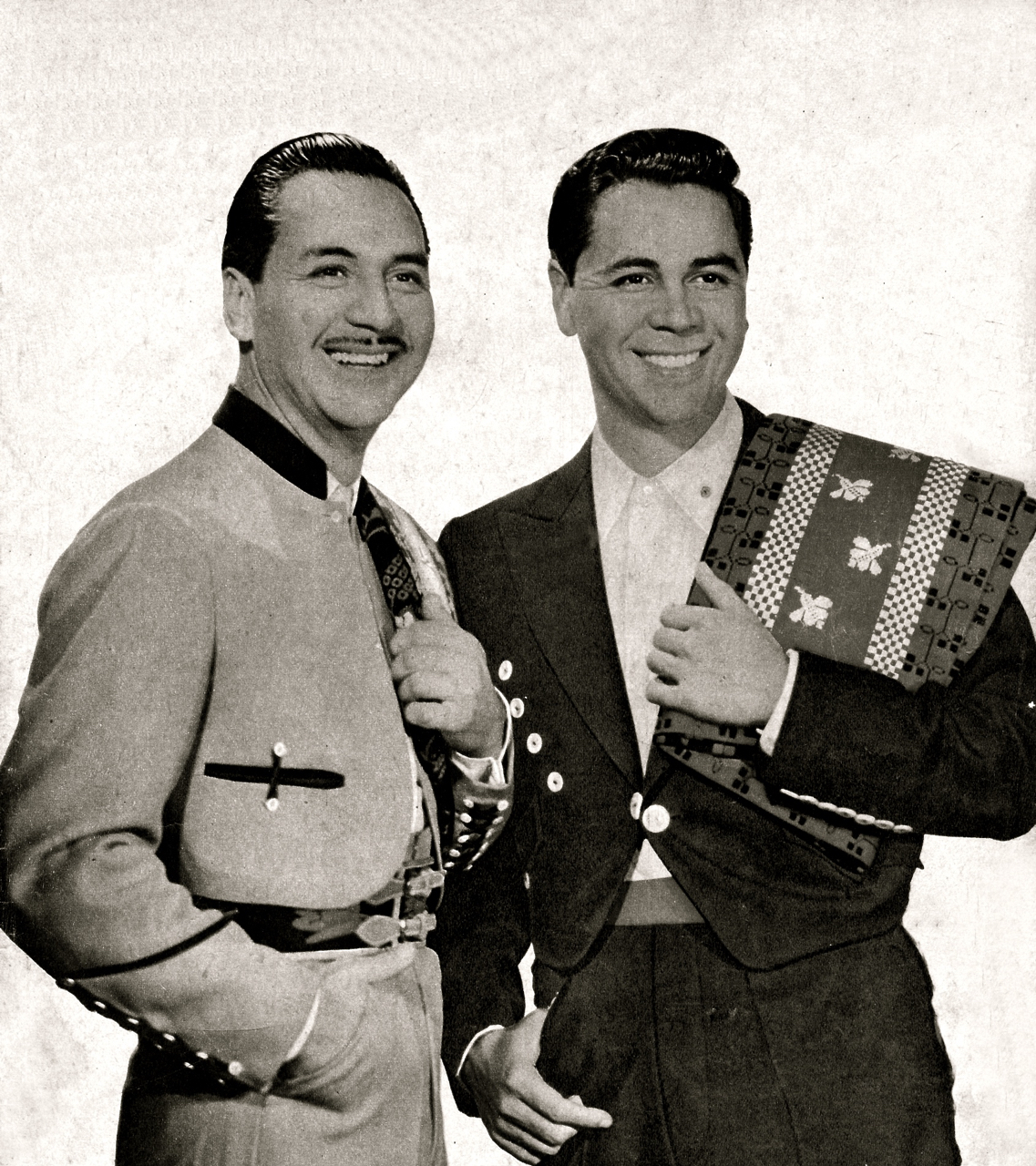 It was his brother Arturo, seven years his senior, who led the way in the music business. Arturo started singing professionally in Rancagua when Lucho was only ten, a shy boy who would hide behind the door when the family gathered for sing-alongs at home. But Arturo recognized his little brother’s talent early, and encouraged him to sing.
It was his brother Arturo, seven years his senior, who led the way in the music business. Arturo started singing professionally in Rancagua when Lucho was only ten, a shy boy who would hide behind the door when the family gathered for sing-alongs at home. But Arturo recognized his little brother’s talent early, and encouraged him to sing.
“So it was my brother who had an enormous influence on my career,” Gatica told journalist Marisol García in a 2007 interview published in La Nación Domingo. “He was already singing on the radio and he would always say, ‘When are you going to join me?’ I never wanted to, until one day we formed a duo. That’s when I started to take singing seriously. Arturo later told me that he had realized I sang better than he did, which was not the case, obviously.”
Lucho attended the Instituto O’Higgins, an all-boys Catholic school run by the Marist Brothers in his hometown. He started performing in Chile’s so-called “revistas de gimnasio,” an annual student showcase of athletic and artistic skills.
In 1941, the two brothers appeared as a vocal duo on local radio. Lucho was just 13, but already his emotive voice was drawing attention. Two years later, the aspiring singer made his first recordings in the same broadcast studio, performing three folkloric songs, including “Negra del Alma.”
By 1945, the two singing siblings had relocated to Santiago, the nation’s capital about 50 miles to the north. Lucho, then 18, continued his studies at another Marist school, the Instituto Alonso de Ercilla. He then enrolled to become a dental technician but never practiced dentistry because his singing career took off so quickly.
Arturo introduced Lucho to Raúl Matas, an influential deejay at Santiago’s Radio Minería, which reached a nationwide audience. The young Lucho soon made his national debut on the host’s popular show, “La Feria de los Deseos,” with the song “Tú, Dónde Estás,” a prototypical bolero of yearning for lost love. The connection with the deejay also led to Lucho’s first recording contract, with the international Odeon label, which later became part of EMI.
Lucho’s professional recording debut came in 1949, again in a duet with his brother. Backed by the Dúo Rey-Silva, the brothers recorded four tonadas, a folkloric style of song and dance. The 78-rpm disc included the titles: “El Martirio,” “Tú Que Vas Vendiendo Flores,” “La Partida,” and “Tilín Tolón.” 
Early on, the Gatica brothers focused on the rich folklore of their native country. The duo appeared on the cover of the magazine Ecran, dressed in the traditional style of the rural huaso, the Chilean charro.
Lucho was also fond of the native music of neighboring Argentina, including the tango, which was enormously popular in Chile during the 1940s. In a 1990 interview in Barcelona, Lucho called himself a pioneer of South American folk music, claiming to be the first to record the songs of Argentina’s Atahualpa Yupanqui, including “Los Ejes de Mi Carreta,” the revered songwriter’s most famous composition.
"I started out doing folk music, but it went very bad for me,” said Lucho, who told the interviewer he still carried a letter from Yupanqui in his suitcase as a keepsake. “At that time, there was no interest in South American folklore, so I turned my attention to boleros instead.”
The timing of Gatica’s stylistic switch could not have been better. It came at the dawn of the 1950s, the beginning of what would become known as the genre’s golden era. Gatica was a natural star—confident, handsome, and ambitious. His one desire was to stand out as a singer.
He did so with a style that was sensual, intimate, and instinctive. Moreover, he brought a fresh approach to the romantic song, breaking with the formal, old-school method, which was more concerned with technique than feeling.
“This was a new bolero,” writes David Ponce, an author specializing in the music of Chile. “In Gatica’s voice, formal recital turned into soft phrasing, and the rhythm became less marked, and more modulated. In the history of the bolero, Gatica did the equivalent of what Sinatra did for the popular American songbook, and to the same effect: gaining intimacy and closeness with the audience.”
 That one-on-one intimacy would only be possible as a solo act, and circumstances conspired to let Lucho go it alone.
That one-on-one intimacy would only be possible as a solo act, and circumstances conspired to let Lucho go it alone.
In 1952, his older brother got married and formed a new act with his wife, Hilda Sour, calling themselves Los Chilenos. (Arturo, Lucho, and Hilda had starred together in the 1950 Chilean film Uno Que Ha Sido Marino.) The following year, the newlyweds left on a world tour of three continents that would keep them away from home for six years. Arturo would later say that there had been a falling out between him and Lucho, and that the brothers didn’t speak for years, although they later reconciled.
Back home, Lucho’s career was taking off. His success would spark a phenomenon that had not been seen before in Latin America, one that would become the stuff of both cheap tabloids and lofty literature.
They called it Luchomania.
The Decade of the Bolero
The bolero in popular music, as opposed to the much older Spanish dance of the same name, has its roots in Santiago de Cuba in the late 1800s, specifically in the style known as trova. In the first decades of the 20th century, the bolero’s popularity expanded worldwide with the growth of the commercial recording industry.
The best boleros have become part of the Latin American songbook, and the top composers have achieved hallowed status in the pantheon of Spanish-language songwriters. Within the Frontera Collection, the bolero ranks No. 2 in the list of the top 20 genres, as reported in the book, The Arhoolie Foundation’s Strachwitz Frontera Collection of Mexican and Mexican American Recordings.
During the 1940s, when Lucho Gatica was still a schoolboy in Rancagua, the bolero gained a foothold in English-language markets, partly through popular films of the day. One of the treasured gems of the genre, “Bésame Mucho,” written by Mexico’s Consuelo Velazquez, became a global hit after it was featured in the 1944 Hollywood musical Follow the Boys, performed by Charlie Spivak and His Orchestra. Gatica would later have a huge hit himself with his interpretation of the song, smoldering with desperate desire. And in the early 1960s, The Beatles recorded their own rendition, with English lyrics.
In tributes to Gatica after his death, several writers mentioned the Beatles cover version, suggesting the fabled band had discovered the tune via the Chilean singer’s recording. But Paul McCartney has said that he first heard “Bésame Mucho” in an upbeat R&B version by the Coasters.
This oft-mentioned anecdote reflects a tendency in posthumous tributes to overstate Gatica’s influence on the genre. The bolero already had several popular interpreters during the 1930s and 40s, including Pedro Vargas, Trio Lo Panchos, Alfonso Ortiz Tirado, María Teresa Vera, Agustín Lara and OIga Guillot. Cuba and Mexico were the reigning powerhouses of the genre, brimming with top singers and composers, long before Gatica entered the arena.
Gatica himself acknowledges his predecessors.
 “I always listened to Leo Marini, Pedro Vargas, Hugo Romani,” he told Chile’s “El Mercurio” newspaper in 1997. “I remember (Colombia’s) Trío Martino came to Chile, and they brought with them the most marvelous boleros, among them, ‘Contigo en la Distancia’ and ‘Nosotros.’ Also visiting were (Mexico’s) Los Tres Diamantes, who sang like gods.”
“I always listened to Leo Marini, Pedro Vargas, Hugo Romani,” he told Chile’s “El Mercurio” newspaper in 1997. “I remember (Colombia’s) Trío Martino came to Chile, and they brought with them the most marvelous boleros, among them, ‘Contigo en la Distancia’ and ‘Nosotros.’ Also visiting were (Mexico’s) Los Tres Diamantes, who sang like gods.”
Gatica does deserve credit for spreading the genre’s popularity, and in some cases making definitive versions of beloved classics. He also had a golden touch for repertoire. He knew instinctively which songs would fit his style. And many of them became hits.
In Santiago, Gatica was exposed to prominent artists from other countries, who shared their music and opened doors for him internationally. In 1951, he met the Cuban singer Olga Guillot, thanks again to an introduction by his brother. And she shared the latest boleros written by her compatriots, pioneer of the style Cubans called “feeling,” or fílin.
“Lucho was thrilled with this new style of bolero,” Guillot told Ena Curnow of Miami’s El Nuevo Herald in 2012, “and he learned ‘La gloria eres tú,’ ‘Contigo en la distancia,’ ‘Delirio,’ and other numbers.”
Also in 1951, Gatica recorded “Piel Canela,” the tropical favorite written by Puerto Rico’s Bobby Capo. He was backed on the Odeon disc by the orchestra of Don Roy, but some critics complained that the accompaniment overshadowed the vocalist.
The following year, he switched to a softer sound with backing by the guitar trio Los Peregrinos, whom he met through deejay Mátas. The trio had been newly formed in Santiago by Bolivia’s Raul Shaw Moreno, known for his stint with Trio Los Panchos. The label convinced the visiting musician to let his group record with Gatica.
Those Odeon sessions in 1952-53 marked the inauguration of his reign as “The Bolero King,” with songs such as the aforementioned “Contigo en la Distancia” by César Portillo de la Luz and “Sinceridad,” by Rafael Gastón Pérez, which became his first big hit in Brazil. Other tracks with Los Peregrinos included "En Nosotros," "Amor, Qué Malo Eres," "Amor Secreto,” and “Vaya con Dios.”
On the Move
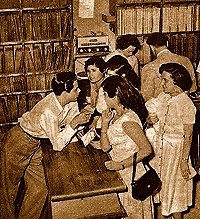 Gatica’s meteoric rise launched him on a series of international tours that would keep him constantly on the road for a decade. He appeared in Cuba for the first time in 1952, as a guest of Guillot. His performances at Havana’s Teatro Blanquita and the fabled Tropicana nightclub are still considered legendary in Cuba, the cradle of the bolero. The singer also made his first television appearance on the island which, according the Cuban website EcuRed, “brought daily life to a stop because everybody wanted to see and hear the King of the Bolero.”
Gatica’s meteoric rise launched him on a series of international tours that would keep him constantly on the road for a decade. He appeared in Cuba for the first time in 1952, as a guest of Guillot. His performances at Havana’s Teatro Blanquita and the fabled Tropicana nightclub are still considered legendary in Cuba, the cradle of the bolero. The singer also made his first television appearance on the island which, according the Cuban website EcuRed, “brought daily life to a stop because everybody wanted to see and hear the King of the Bolero.”
Gatica’s first international tour came the following year, taking him to Colombia, the U.S., Spain and finally England, where he recorded at the EMI studios that would later become known as Abbey Road.
The British label matched Gatica with another of their artists, Scottish pianist and bandleader Roberto Inglez (born Robert Inglis), who worked with a young producer named George Martin, later of Beatles fame. The transcontinental collaboration yielded four songs: two in Portuguese, “Samba Chamou” and “No Tem Soluçao,” and two in Spanish, “Las Muchachas de la Plaza España” and the evergreen “Bésame Mucho”.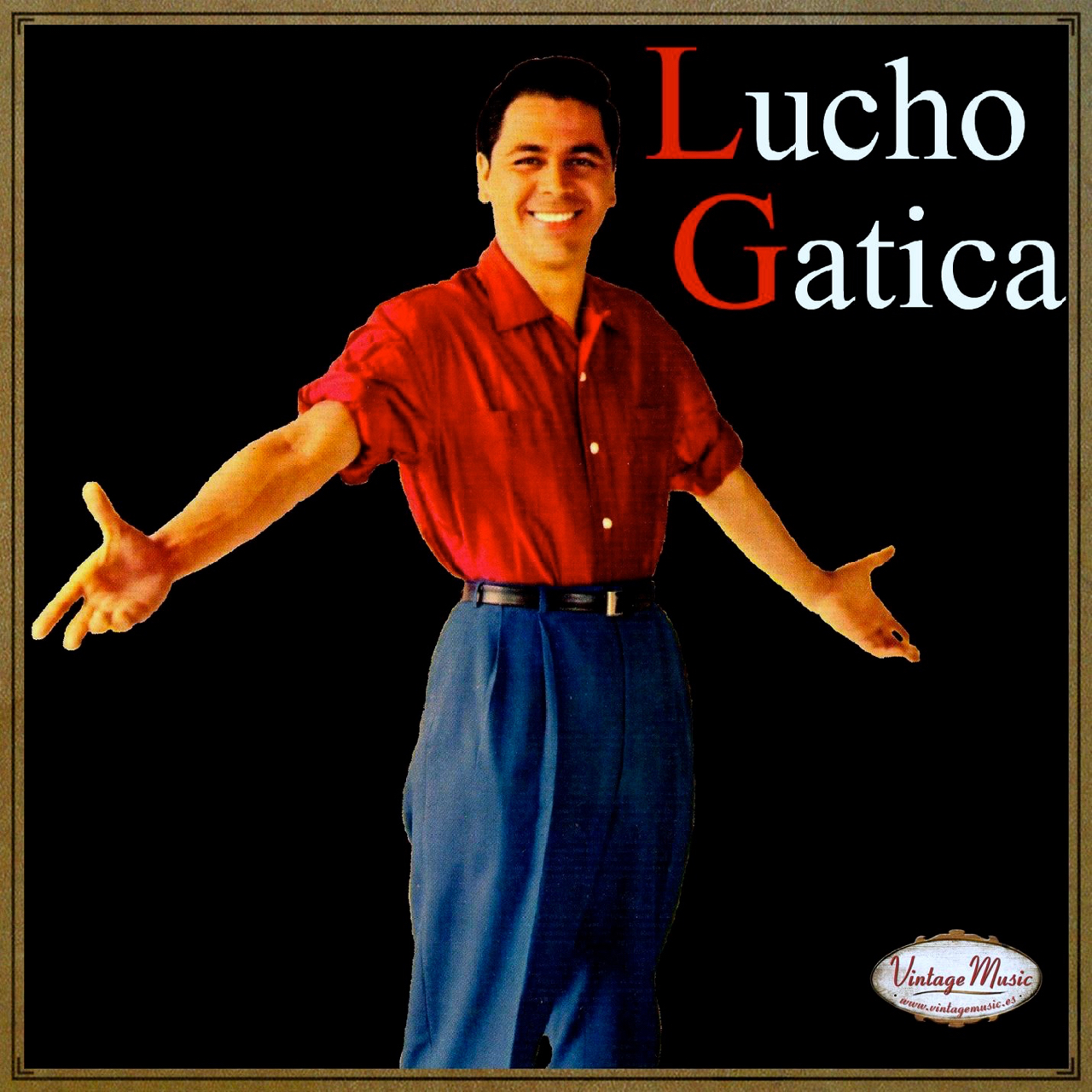
Inglez and his orchestra joined Gatica in Chile in 1954, and the two artists set out on an international tour that caused pandemonium at almost every stop. In Lima, the sensation caught the attention of Peruvian novelist Mario Vargas Llosa. In his book, La Tía Julia y el Escribidor, the writer describes frenzied female fans pursuing the sexy singer until he was left in just his shoes and shorts.
Gatica sparked the same furor in Buenos Aires, Uruguay, and Brasil. “Females went after a piece of anything that belonged to their idol: a lock of hair, a handkerchief, a sleeve of his shirt … anything,” writes Omar Martinez, on the blog Luchoweb.
By 1955, Gatica was at the top of his game. He was ready for his next big move: establishing his home in Mexico City, bolero capital of the world.
Mid-century Mexico was the hub of the Latin American entertainment industry, a leader in music and film production for the continent. But breaking into that establishment was not easy, especially for an outsider.
“Listen, México at that time was an extreme bunker of nationalism,” said Odeon Chile’s artistic director Rubén Nouzeilles, in an interview on a Chilean music website. “Nobody could go there to sing boleros because that was the patrimony of the Mexicans, just as nobody would think of donning a charro hat and go compete with (a mariachi star). Lucho Gatica, apart from being a great artist, was also a conquistador.”
And the conquest was swift. The singer quickly became part of bolero royalty in Mexico. He was soon turning out hit after hit, hosting his own TV show, and making a series of films with Mexico’s biggest stars.
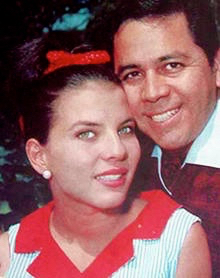 Gatica had his pick of songs by the country’s top composers: “Solamente Una Vez” and “María Bonita” by Agustín Lara; “Un Poco Mas” by Alvaro Carrillo; “La Puerta” by Luis Demetrio; “Nunca” by Guty Cardenas; and the crossover classic “Perfidia” by Alberto Domínguez. But it was with “No Me Platiques Más” by Mexican composer Vicente Garrido that he scored an early hit that would become his signature song. In 1956, he performed the number in the film of the same name, almost whispering the tune into the ear of his lovely co-star, a former Miss Mexico.
Gatica had his pick of songs by the country’s top composers: “Solamente Una Vez” and “María Bonita” by Agustín Lara; “Un Poco Mas” by Alvaro Carrillo; “La Puerta” by Luis Demetrio; “Nunca” by Guty Cardenas; and the crossover classic “Perfidia” by Alberto Domínguez. But it was with “No Me Platiques Más” by Mexican composer Vicente Garrido that he scored an early hit that would become his signature song. In 1956, he performed the number in the film of the same name, almost whispering the tune into the ear of his lovely co-star, a former Miss Mexico.
Gatica had an ear for hits.
He proved this when he first heard a song that would become one of the most beloved boleros of all time, especially among Mexican-Americans. The singer was in Barcelona when, as he recalled in recent interview, he got a call from an associate in Mexico pitching a new song. The caller sang a snippet over the phone, and that was enough for Gatica. He dropped everything on the spot and flew back to Mexico to record Alvaro Carrillo’s unforgettable “Sabor a Mí.”
He could also spot talented new songwriters.
In 1959, Gatica collaborated with an up-and-coming composer from Veracruz named Armando Manzanero. He recorded “Voy a Apagar la Luz” by the 24-year-old, who would become one of Mexico’s most celebrated pop songwriters during the 1960s and ’70s. The two artists also launched a tour of the United States, with Manzanero accompanying Gatica on piano.
Near the end of the decade, Gatica recorded two immortal tunes by Mexico’s Roberto Cantoral, “El Reloj” and “La Barca.” Both songs have since been recorded hundreds of times by such varied artists as Plácido Domingo, Joan Báez, and Linda Ronstadt. Forty years later, however, it was Gatica’s version of those two classics that was inducted into the inaugural Latin Grammy Hall of Fame (2001), along with Santana's "Oye Como Va" (1970) and Antonio Carlos Jobim’s "The Girl From Ipanema" (1963).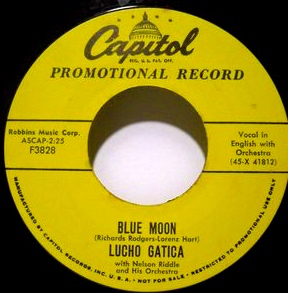
Through these peak years, Gatica sustained a touring itinerary that was both hectic and glamorous.
In 1957, he returned to Cuba in an emotional show before 30,000 people at Havana’s Gran Estadio. He wept when he was surprised on stage by his mother, whom he hadn’t seen in years and who had been secretly flown in from Santiago for the occasion. Gatica also played a more intimate venue at the Hotel Nacional’s Cabaret Parisién, accompanied on piano by famed fílin composer Frank Domínguez, who wrote the immortal bolero “Tú Me Acostumbraste.”
As the decade came to a close, Gatica made his first trip to Spain, where he was received like a head of state. Thousands of fans lined the streets of Madrid, carrying flags and homemade welcome signs as the star waved back from his passing convertible. His performances in the Spanish capital during 1959 were, as Omar Martinez wrote in a 2007 essay, “social events which attracted royalty, politicians, movie stars and jet setters from all over Europe.”
Luchomania had gone global. Gatica shared the stage in Paris with Edith Piaff. He performed in Monte Carlo at the invitation of Princess Grace. And he appeared before a massive crowd in the Philippines at the same arena where, years later, boxers Muhammad Ali and Joe Frazier would hold the "Thrilla in Manila."
Back in the U.S., Gatica was also making waves in the entertainment industry.
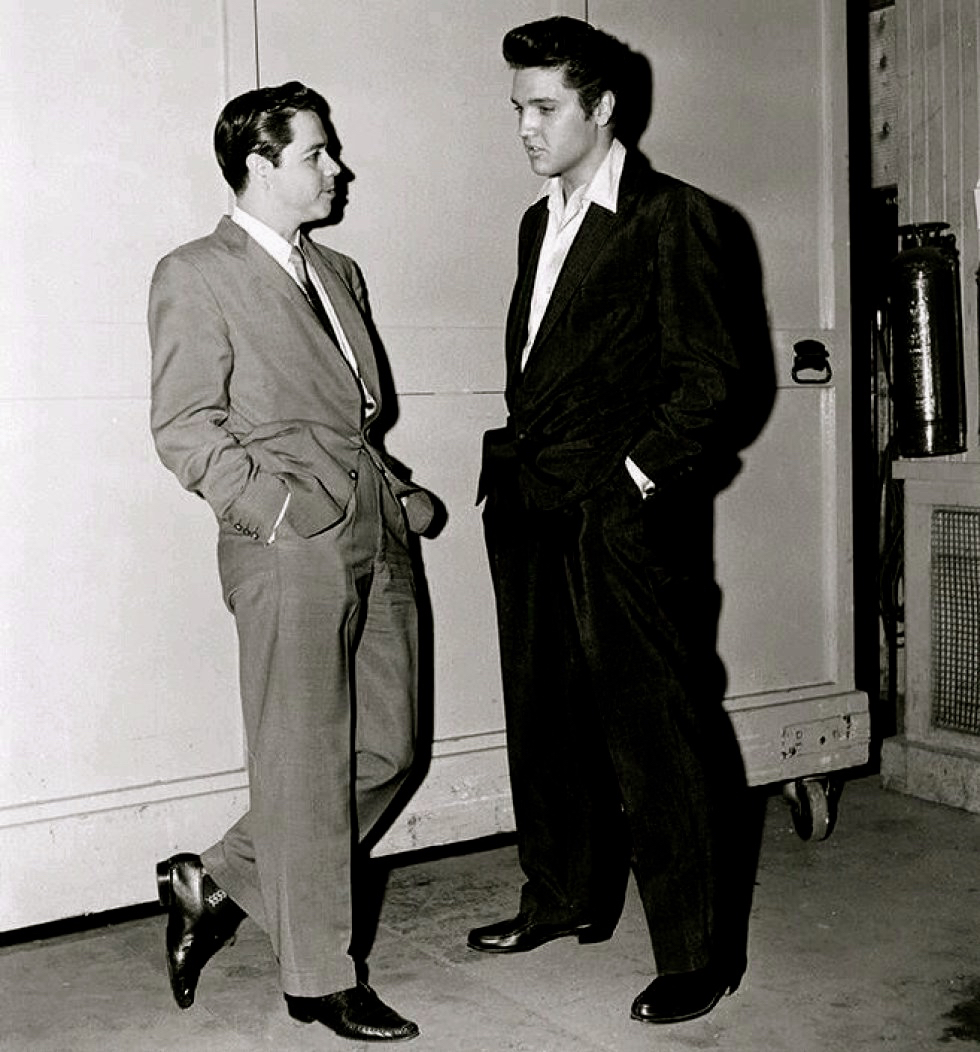 The handsome Chilean hobnobbed with Hollywood celebrities, attending gatherings hosted by the film studio Metro-Goldwyn-Mayer. He famously met Elvis Presley at MGM, during a break in the filming of Jailhouse Rock. A photograph from that encounter rocketed around the world, and was frequently mentioned in Gatica’s obituaries six decades later. As the Mexican newspaper Vanguardia recalled: “Here was the King of Rock and the King of the Bolero, one on one, absolute monarchs in their respective genres.”
The handsome Chilean hobnobbed with Hollywood celebrities, attending gatherings hosted by the film studio Metro-Goldwyn-Mayer. He famously met Elvis Presley at MGM, during a break in the filming of Jailhouse Rock. A photograph from that encounter rocketed around the world, and was frequently mentioned in Gatica’s obituaries six decades later. As the Mexican newspaper Vanguardia recalled: “Here was the King of Rock and the King of the Bolero, one on one, absolute monarchs in their respective genres.”
Gatica also became a sought-after celebrity guest on American television during the 1950s, appearing on the variety shows of Dinah Shore, Perry Como, Patti Page, and the era’s ultimate entertainment showcase, “The Ed Sullivan Show.” He also recorded for the first time in English with the orchestra of Nelson Riddle, the music director for Frank Sinatra, who had a lifelong friendship with his Chilean counterpart. Though they weren’t hits, recordings from those sessions on Capitol Records, including “Blue Moon” and “Mexicali Rose,” are now prized by record collectors.
Capitol did much better with reissues of Gatica’s Latin American repertoire, introducing Americans to a golden archive of romantic boleros. Under the label’s “Capitol of the World” series, the company released several Gatica albums in rapid succession, starting in 1956 with South American Songs, a folk collection recorded in Chile. In 1960, Capitol issued Lara by Lucho, with songs by Agustín Lara, recorded in Mexico with the orchestra of frequent collaborator José Sabre Marroquín.
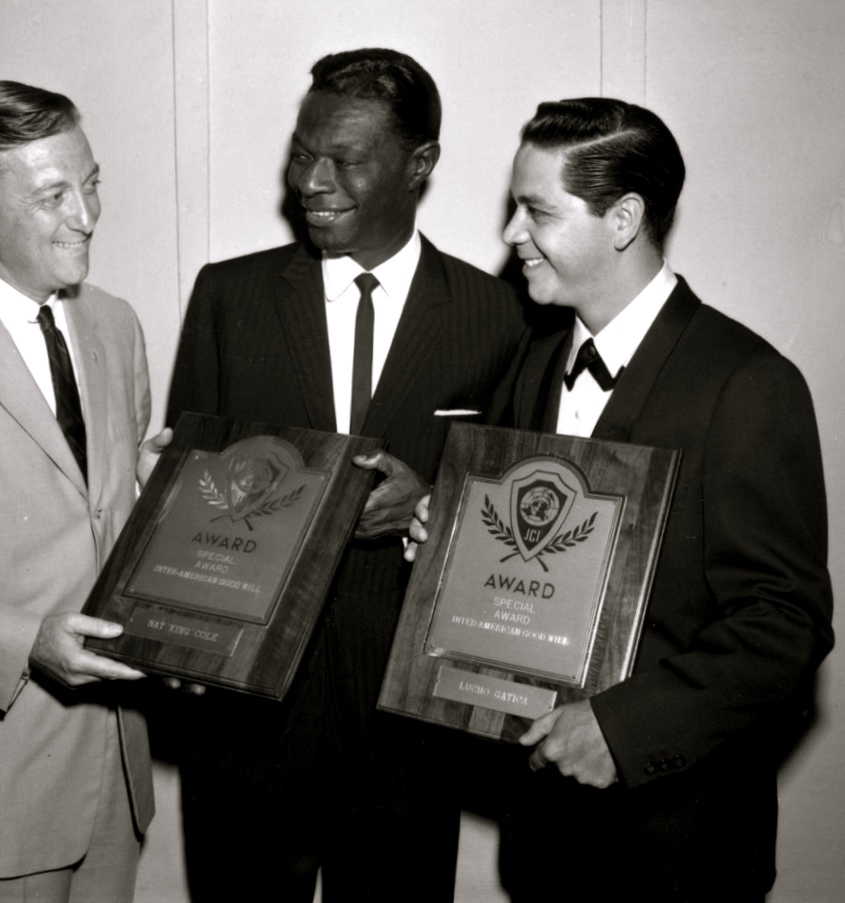 During this same period, Capitol was also hitting it big with a series of Spanish-language albums by popular crooner Nat “King” Cole, who had a friendship with Gatica. The two singers had met earlier in Havana, where Gatica introduced Cole at the fabled Tropicana nightclub. Cole would get the chance to return the gesture on his L.A. home turf, introducing Gatica at the Hollywood Bowl on the night of Wednesday, July 22, 1959.
During this same period, Capitol was also hitting it big with a series of Spanish-language albums by popular crooner Nat “King” Cole, who had a friendship with Gatica. The two singers had met earlier in Havana, where Gatica introduced Cole at the fabled Tropicana nightclub. Cole would get the chance to return the gesture on his L.A. home turf, introducing Gatica at the Hollywood Bowl on the night of Wednesday, July 22, 1959.
The Bowl concert would be followed four years later by another milestone, Gatica’s appearance at Carnegie Hall on April 5, 1963. In what The New York Times called “a bravura performance,” Gatica was backed by a symphony orchestra conducted by Argentina’s Lalo Schifrin. Gatica’s opening night show was broadcast live by radio to his native country.
No matter where he travelled or lived, Gatica always gave credit to Mexico as the launching pad of his career, and the fulfillment of a childhood dream.
“I came to the country that was the temple of the bolero,” he told reporter Marisol García in a 2007 interview for La Nación Domingo. “All the singers who I admired were all in Mexico, during their glory days. The competition was tremendous! Who could ever imagine that, having heard their music in Chile through long-wave radio on “La Voz de América Latina” (broadcast by Mexico’s XEW), I would wind up working with all of these artists.” 
Gatica found more than career success in Mexico. He also found love.
In 1960, he married his first wife, María del Pilar Mercado Cordero, a former Miss Puerto Rico (1957) and popular film actress known as Mapita Cortés. The couple had five children, including first-born Luis, who became a successful actor, and the youngest, Alfredo, a music producer.
After 18 years of marriage, the glamorous celebrity couple divorced.
It was 1978 and Gatica was turning 50. The bolero craze had cooled. The splendor of his seductive tenor had faded. And his recording prospects had dwindled.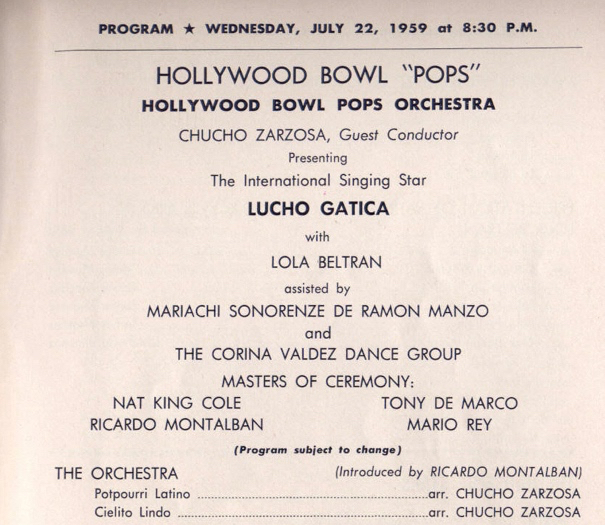
It was time to make another change.
The middle-aged singer moved to Los Angeles. Luchomania was a thing of the past, but the aging star would not be forgotten. The last half of his life would bring belated tributes, as well as recognition from a new generation of romantic singers.
The Comeback
By the mid-1980s, an entirely new set of superstars dominated the lucrative Latin field of romantic pop music: Spain’s Julio Iglesias, Venezuela’s Jose Luis Rodriguez, Mexico’s José José, and the United States’s Vikki Carr and Gloria Estefan.
These and a host of other top artists gathered at A&M Studios in Los Angeles in the spring of 1985 to record the Latin version of “We Are the World,” the famous charity song for famine relief written by Michael Jackson and Lionel Richie. The Spanish version, "Cantaré, Cantarás," also became a pop music phenomenon, covered prominently in the Los Angeles Times. Gatica was also part of the all-star ensemble, but during the recording, he was positioned in the top row, at the rear, just another member of the chorus.
From his remote perch, Gatica watched as younger balladeers took the spotlight. The Chilean singer, who once caused near-riots by his very presence, was hardly noticed at the event that day. The pecking order in the studio was a symbol of how far his star had fallen. And it begged the question: Would he have even been invited if the record had not been co-produced by his nephew, Humberto Gatica, who by then was a top engineer with clients of the caliber of Michael Jackson, Tina Turner, and Barbra Streisand? 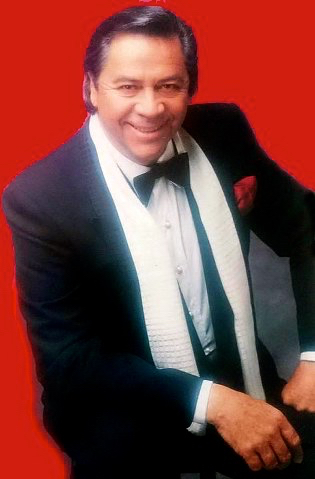
Not everybody relegated Gatica to the back burner in his later years. In May 1990, he made a triumphant return to Madrid, after a 10-year absence. His legacy had received a boost from celebrated Spanish filmmaker Pedro Almodóvar, who had used Gatica’s song “Encadenados” in the soundtrack to his 1983 film Entre Tinieblas.
The Chilean singer, at age 62, returned to Florida Park, the venue where he had debuted three decades earlier. The place was buzzing with the capital’s glitterati, who came to see him, and to be seen.
“From the moment Lucho began to sing, everybody became lovers,” wrote critic Maruja Torres in El País. “They applauded the man who proved that with time, wisdom flawlessly replaces power. He doesn’t sing like he did before, nor does he try. Instead, it was like he revisited each song from the perspective that irony and maturity provide.”
It was a fitting start for a decade that would see the resurgence of the old boleros Gatica had popularized. The genre’s ’90s revival was propelled by a series of fabulously successful albums by young Mexican singing idol Luis Miguel, introducing a new generation of fans to the classic pop music of their parents and grandparents.
The trend also brought new audiences to Gatica. In 1995, at the apex of his bolero phase, Luis Miguel invited Gatica on stage at the former Universal Amphitheatre in Los Angeles, greeting his aging predecessor with a hug and a kiss on the cheek. The following year, Luis Miguel joined a constellation of top stars in a televised tribute to Gatica, produced by HBO, at Miami’s James L. Knight Center. The two-hour special featured Gatica in duets with Juan Gabriel, José José, Julio Iglesias, and his old friend from Cuba, Olga Guillot.
By the end of the century, the King of the Bolero had been enthroned anew, this time as “elder statesman” of the romantic musical tradition of Latin America.
The Swan Song
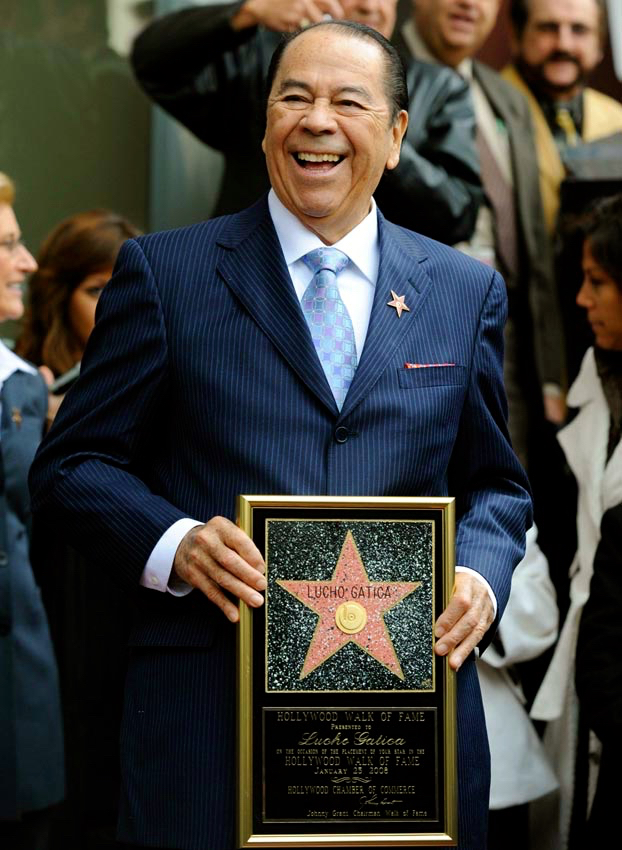 Gatica went on to receive more major honors in the new millennium. In 2008, the year he turned 70, he became one of only two Chileans (the other being TV host Don Francisco) to receive a star on the Hollywood Walk of Fame. Later that year, the Latin Recording Academy honored him with a trophy for lifetime achievement.
Gatica went on to receive more major honors in the new millennium. In 2008, the year he turned 70, he became one of only two Chileans (the other being TV host Don Francisco) to receive a star on the Hollywood Walk of Fame. Later that year, the Latin Recording Academy honored him with a trophy for lifetime achievement.
For Gatica, however, one important thing was still missing: the full appreciation of his fellow countrymen. Many Chileans felt ambivalent about his international success, which had required him to live most of his life away from home. “Gatica will be remembered in the country as the lost son, who died a faraway hero,” declared Chile Today in its English-language obituary.
Nevertheless, Gatica received multiple national honors from the Chilean government and arts community: Gaviota de Oro at Chile’s famed the song festival at Viña del Mar (1992); Medalla de Oro from Chile’s author’s rights society, Sociedad Chilena de Derechos de Autor, bestowed personally by Chilean President Michelle Bachelet (2007); Orden al Mérito Artístico y Cultural Pablo Neruda, named for the famed Nobel laureate (2012).
Gatica received his country’ highest cultural award in 2002, on the 50th anniversary of his professional career. He was awarded the Orden al Mérito Gabriela Mistral, joining previous recipients that included Paul McCartney.
In acknowledging the honor, Gatica paid tribute to his brother, who had died in 1996. “I would have wanted my brother Arturo to be here too,” he said, “because he was to blame for me being an artist who has given a measure of renown to my country.”
The following year, at age 75, Gatica collaborated with Chilean hip-hop stars Ana Tijoux and Víctor Flores on “Me Importas Tú,” a contemporary reimagining of his old bolero, “Piel Canela,” on which Gatica sticks to reciting rather than singing the original lyric.
Gatica made his final recording in 2013, at age 85. Titled “Historia de Un Amor,” the work was once again co-produced by his nephew, Humberto Gatica. It featured duets with a host of contemporary singers, including Luis Fonsi, Laura Pausini, Michael Bublé, Nelly Furtado, and Beto Cuevas of the Chilean rock band La Ley.
The singer’s attempt to find renewed relevance fell flat. Even so, he was content in his later years, as he would tell reporters, because he had led a full life. 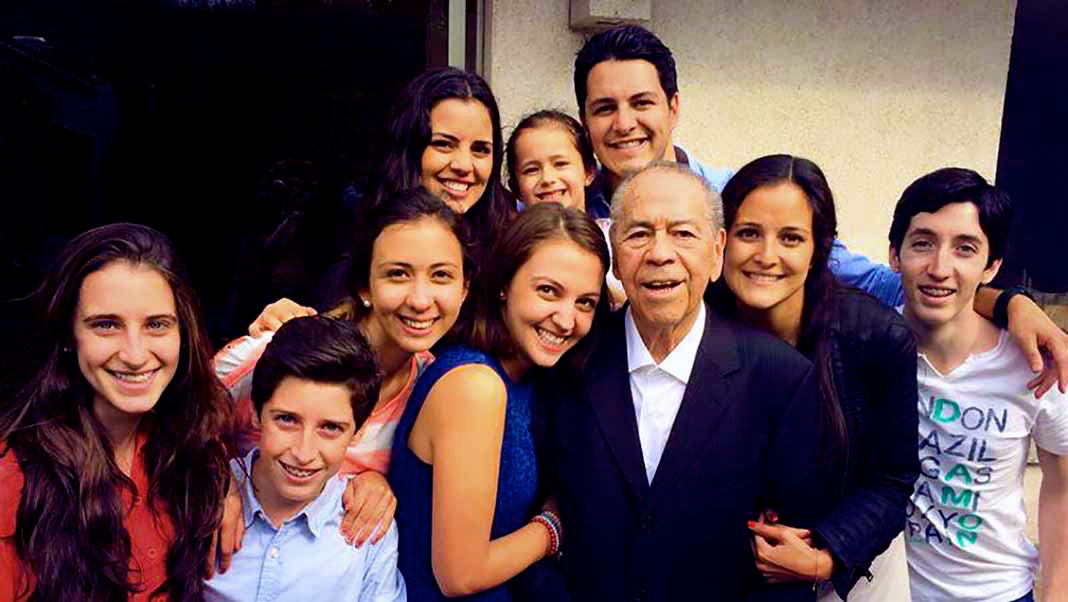
Ever the romantic, Gatica married twice after his initial divorce, and had two more daughters, one by each wife. In 1986, the year he turned 58, he wed his third and final wife, Leslie Deeb, who gave birth to his seventh and final child. Both of his youngest daughters, Luchana (goddaughter of Julio Iglesias) and Lily Teresa, are in show business in the Unites States.
The singer celebrated his 90th birthday this year in Mexico City, three months before he died. One news report described a sad picture of the artist in his final days, suffering from diabetes and diminishing mental capabilities, playing records and spending hours singing at home by himself.
Yet, photos from his birthday celebration show him smiling broadly, surrounded by his eleven grandchildren. The youngsters had prepared a surprise gift: a recording of his famous boleros, in their own voices.
 That same day, civic leaders in his hometown unveiled a 6-foot bronze statue depicting the Gatica brothers as they had started, Lucho singing into a mic and Arturo playing guitar. Gatica himself was well aware of his artistic legacy, which he once succinctly summarized for a magazine reporter.
That same day, civic leaders in his hometown unveiled a 6-foot bronze statue depicting the Gatica brothers as they had started, Lucho singing into a mic and Arturo playing guitar. Gatica himself was well aware of his artistic legacy, which he once succinctly summarized for a magazine reporter.
"As long as people fall in love,” he said, “my songs will be popular."
– Agustín Gurza
Añade una nota